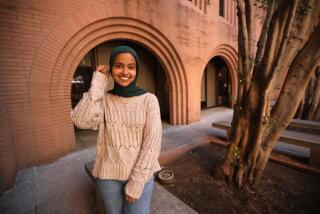Crime Lab Brings Closure to Tough Cases
On the second floor of the Los Angeles County Sheriff’s crime lab, technicians running computer checks on fingerprints from a 45-year-old double murder made a startling discovery last winter that provided a powerful example of how science and technology can mean the difference between an open case and a shut case.
The partial fingerprints, run through a Federal Bureau of Investigations database, matched those of 69-year-old South Carolina businessman Gerald F. Mason.
But technicians weren’t finished. They then produced additional links between Mason and the crime, based on an analysis of handwriting samples and ballistics.
On the strength of that evidence, Mason pleaded guilty to murdering two El Segundo police officers in 1957 and was sentenced to life in prison.
Firearms analysis, handwriting evaluation and latent prints that broke the case open after almost a half-century are a few of the specialties of the Sheriff’s crime lab, which marked its 75th anniversary this month.
Los Angeles County Dist. Atty. Steve Cooley and Sheriff Lee Baca both praised the technicians who have helped solve high-profile cases such as the Mason killings, the murder of model Linda Sobek, the serial killings of “Night Stalker “ Richard Ramirez, and tens of thousands of other cases.
More then 200 people, including scientists, technicians and administrative staff work at the lab, which annually process an estimated 75,000 pieces of evidence, ranging from blood work and hair to carpet fibers, paint flecks and shoeprints, at its downtown lab on Beverly Boulevard. The department has a facility in Downey that specializes in drug and alcohol evidence. Drug testing is also handled regionally at satellite offices in West Covina, Lynwood and Lancaster.
“It’s a pretty busy place,” said Barry A.J. Fisher, director of scientific services. “In the high-volume areas of the lab, we tend to get those cases out pretty quickly, well under a week.”
“It’s the serious crime we tend to fall behind on, because there’s a lot more evidence,” he said. “And examining that evidence is very time-consuming.”
Half the work is for cases investigated by the sheriff. The rest are referred by more than 100 local law enforcement agencies, including state and local police departments such as Pasadena and Santa Monica, as well as federal entities including the FBI and the Bureau of Alcohol, Tobacco, Firearms and Explosives. The lab also handles special requests for the Los Angeles Police Department, which has its own crime lab but sometimes comes to the Sheriff’s lab with rush cases.
First known as the Laboratory of Criminological Research, the lab was established in the Hall of Justice in 1928. It employed two people, who processed firearms, fingerprint and other physical evidence.
With the advance of technology in the 1950s and ‘60s, the lab moved to Main Street, adding specialties such as polygraphs, document and handwriting identification, toxicology, breath and video analysis.
Evidence goes to specialty areas within the lab, including biology and DNA, firearms, latent prints, narcotics, trace evidence, questioned documents and toxicology.
The firearms identification section in the basement compares, analyzes and tests weapons, ammunition, cartridges and casings, and restoresserial numbers that have been taken off guns.
Decades worth of latent prints, about 60,000 in all, are stored on the second floor in rows of tall filing cabinets. More recently, technicians have entered prints on state and federal computer databases.
Down the hall is the trace evidence area, where, as Fisher puts it, “you can let the Sherlock Holmes side of you wander.” Here, lab workers examine any object from crime scenes, such as rope, cosmetics, condiments or the bumper of a car used in a hit-and-run.
One of the fastest growing areas of the lab in the last decade has been the forensic biology section, which examines blood and other bodily fluids for DNA.
In solving old and new cases, the technology has also fueled the public imagination and provided plot lines for movie and television dramas.
It also has increased expectations to sometimes unrealistic levels.
“People think we can wrap these cases up in an hour,” Fisher said. “The reality is, if we got it right away, it could take a couple of weeks.”
California requires that many people convicted of crimes provide DNA samples. In 2002, the state added such offenses as residential burglary, residential robbery, arson and carjacking to the list.
By expanding information available in state and federal computerized databases of offenders’ DNA and fingerprints as well as ballistics information on firearms, detectives are solving more and more crimes.
Now officials are planning a new forensics crime lab on the campus of Cal State Los Angeles.
Disagreements over how much the LAPD and the Sheriff’s Department should share personnel, equipment and space in the $96-million facility have delayed the opening to 2006.
“Potentially, the number of cases [we handle] could double or triple,” Fisher said of the new facility. “That comes down to a budget decision.”
More to Read
Start your day right
Sign up for Essential California for news, features and recommendations from the L.A. Times and beyond in your inbox six days a week.
You may occasionally receive promotional content from the Los Angeles Times.






